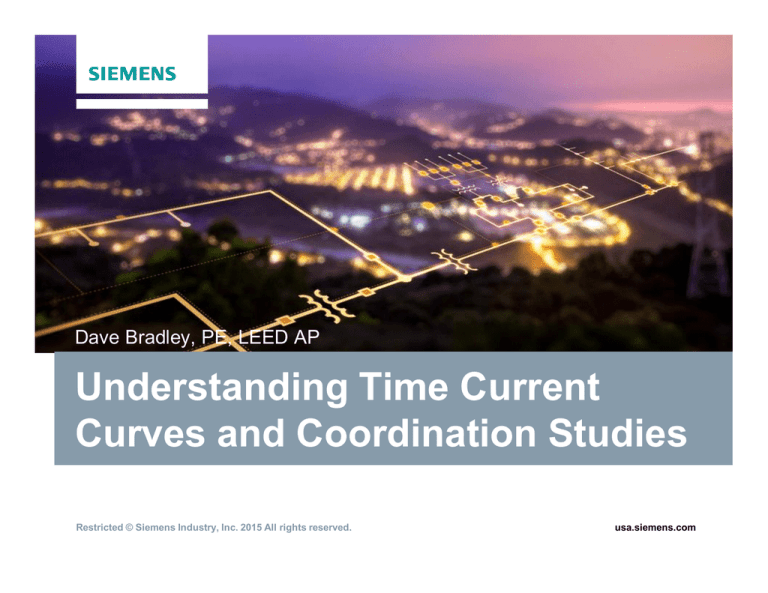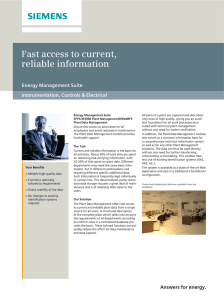
Dave Bradley, PE, LEED AP
Understanding Time Current
Curves and Coordination Studies
Restricted © Siemens Industry, Inc. 2015 All rights reserved.
usa.siemens.com
In This Elective
• Time Current Curve Basics
• Uses of Time Current Curves
• Coordination Study Basics
Restricted © Siemens Industry, Inc. 2015 All rights reserved.
Page 2
How will this help me next week?
• Better understanding circuit breakers
• Understand what TCCs can be used for,
and for what they shouldn’t be used
• Understand general differences between
coordination and Selective Coordination
Restricted © Siemens Industry, Inc. 2015 All rights reserved.
Page 3
Where did it all start?
Restricted © Siemens Industry, Inc. 2015 All rights reserved.
Page 4
In the beginning...
Restricted © Siemens Industry, Inc. 2015 All rights reserved.
Page 11
Inverse Time Element
Current
Time
Restricted © Siemens Industry, Inc. 2015 All rights reserved.
Page 12
How It Works
Restricted © Siemens Industry, Inc. 2015 All rights reserved.
Page 13
How it Works – Thermal Magnetic
Tripping
“foot”
Contacts
Load
Connection
Line
Connection
Electromagnet
Bi-Metallic Strip
Restricted © Siemens Industry, Inc. 2015 All rights reserved.
Page 14
How it Works – Solid State
Restricted © Siemens Industry, Inc. 2015 All rights reserved.
Page 15
Time Current Curves
Restricted © Siemens Industry, Inc. 2015 All rights reserved.
Page 16
0
TIME
How to Show a Wide Range on a Small Paper
0
CURRENT
Restricted © Siemens Industry, Inc. 2015 All rights reserved.
Page 17
Logarithmic Time
1,000s
100s
10s
1s
100ms
10ms
Restricted © Siemens Industry, Inc. 2015 All rights reserved.
Page 18
Logarithmic Current
10A
100A
1,000A 10,000A 100,000A
Restricted © Siemens Industry, Inc. 2015 All rights reserved.
Page 19
Time Current Curves in the Real World
14
Restricted © Siemens Industry, Inc. 2015 All rights reserved.
Page 20
Time Current Curves in the Real World
20
14
Restricted © Siemens Industry, Inc. 2015 All rights reserved.
Page 21
Time Current Curves in the Real World
20
M
14
10HP
14
Inrush Currents
• 20x for ½ cycle
• 4-8x for several seconds
Restricted © Siemens Industry, Inc. 2015 All rights reserved.
Page 22
Time Current Curves in the Real World
20
30
M
14
10HP
14
Inrush Currents
• 20x for ½ cycle
• 4-8x for several seconds
Restricted © Siemens Industry, Inc. 2015 All rights reserved.
Page 23
Time Current Curves in the Real World
36
30kVA
30
20
M
14
10HP
14
Inrush Currents
• Worst case: 14x +
• Average: 5x for a couple of cycles
Restricted © Siemens Industry, Inc. 2015 All rights reserved.
Page 24
Time Current Curves in the Real World
90
36
30kVA
30
20
M
14
10HP
14
Inrush Currents
• Worst case: 14x +
• Average: 5x for a couple of cycles
Restricted © Siemens Industry, Inc. 2015 All rights reserved.
Page 25
Time Current Curves in the Real World
250
90
100
30kVA
20
36
30
M
14
Restricted © Siemens Industry, Inc. 2015 All rights reserved.
Page 26
14
10HP
Time Current Curves – Thermal Magnetic
1985
Restricted © Siemens Industry, Inc. 2015 All rights reserved.
Page 27
2006
Time Current Curve Details
Restricted © Siemens Industry, Inc. 2015 All rights reserved.
Page 28
Changes to New TCCs
OLD
NEW
Restricted © Siemens Industry, Inc. 2015 All rights reserved.
Page 29
Molded Case Switches
Motor Circuit Protectors
Restricted © Siemens Industry, Inc. 2015 All rights reserved.
Page 30
Thermal Magnetic vs Electronic
Restricted © Siemens Industry, Inc. 2015 All rights reserved.
Page 31
Time Current Curves – Electronic
Long Time
• Handle Rating
• Overloads
Restricted © Siemens Industry, Inc. 2015 All rights reserved.
Page 32
Time Current Curves – Electronic
Long Time Delay
• Normal Inrush
Restricted © Siemens Industry, Inc. 2015 All rights reserved.
Page 33
Time Current Curves – Electronic
Short Time
• Coordination
• Curve Matching
Restricted © Siemens Industry, Inc. 2015 All rights reserved.
Page 34
Time Current Curves – Electronic
Short Time Delay
• Coordination
• Curve Matching
Restricted © Siemens Industry, Inc. 2015 All rights reserved.
Page 35
Time Current Curves – Electronic
Instantaneous
• Faults
Restricted © Siemens Industry, Inc. 2015 All rights reserved.
Page 36
Uses of TCCs
Restricted © Siemens Industry, Inc. 2015 All rights reserved.
Page 37
Time Current Curve Software – EasyTCC
Restricted © Siemens Industry, Inc. 2015 All rights reserved.
Page 38
Time Current Curve Software – SKM
Restricted © Siemens Industry, Inc. 2015 All rights reserved.
Page 39
Coordination Studies
Restricted © Siemens Industry, Inc. 2015 All rights reserved.
Page 40
Uses of TCCs - Coordination
Restricted © Siemens Industry, Inc. 2015 All rights reserved.
Page 41
Selectivity
Restricted © Siemens Industry, Inc. 2015 All rights reserved.
Page 43
Coordination
0.1s
800
250
100
Restricted © Siemens Industry, Inc. 2015 All rights reserved.
Page 44
Selective Coordination
0.01s
800
260
100
Restricted © Siemens Industry, Inc. 2015 All rights reserved.
Page 45
Behavior in the Field
Restricted © Siemens Industry, Inc. 2015 All rights reserved.
Page 46
Uses of TCCs
For application and coordination purposes only. Based on 40°C
ambient cold start. Connected with 4 feet of rated wire (75°C) per terminal. Tested in open air with
current in all poles.
Restricted © Siemens Industry, Inc. 2015 All rights reserved.
Page 47
Uses of TCCs - Operation and Testing
Restricted © Siemens Industry, Inc. 2015 All rights reserved.
Page 48
Uses of TCCs - Operation and Testing
Restricted © Siemens Industry, Inc. 2015 All rights reserved.
Page 49
40ºC
25ºC
NEMA
AB-4
(104ºF)
Restricted © Siemens Industry, Inc. 2015 All rights reserved.
Page 50
Same Device, Different Settings
The purple time current curve (TCC)
reflects how the breaker is set when
it leaves the plant
The blue TCC shows one possibility
for how the breaker could be set.
This leave a fairly wide range of
possible settings
Restricted © Siemens Industry, Inc. 2015 All rights reserved.
Page 55
Effect of Incorrect Settings
Add in the feed to the air conditioner
and you can see why the main
breaker tripped out
Restricted © Siemens Industry, Inc. 2015 All rights reserved.
Page 56
Summary
Restricted © Siemens Industry, Inc. 2015 All rights reserved.
Page 58
Summary
• You know how loads and circuit breakers
interact, and how the time current curve
shows that
• You understand what TCCs can be used for,
and for what they shouldn’t be used
• You can now better address initial questions
about breaker performance in the field
• You know the general differences between
Coordination and Selective Coordination
Restricted © Siemens Industry, Inc. 2015 All rights reserved.
Page 59
Questions?
Restricted © Siemens Industry, Inc. 2015 All rights reserved.
Page 60





